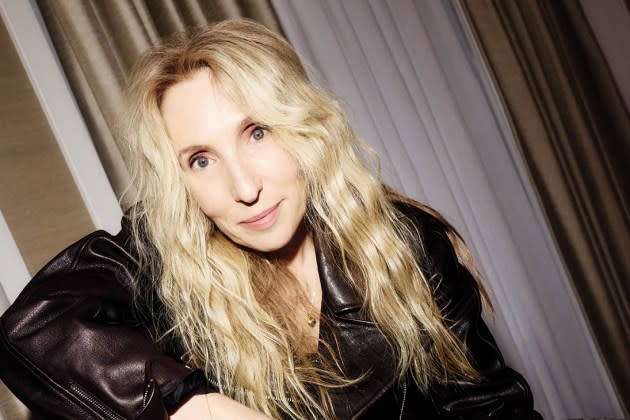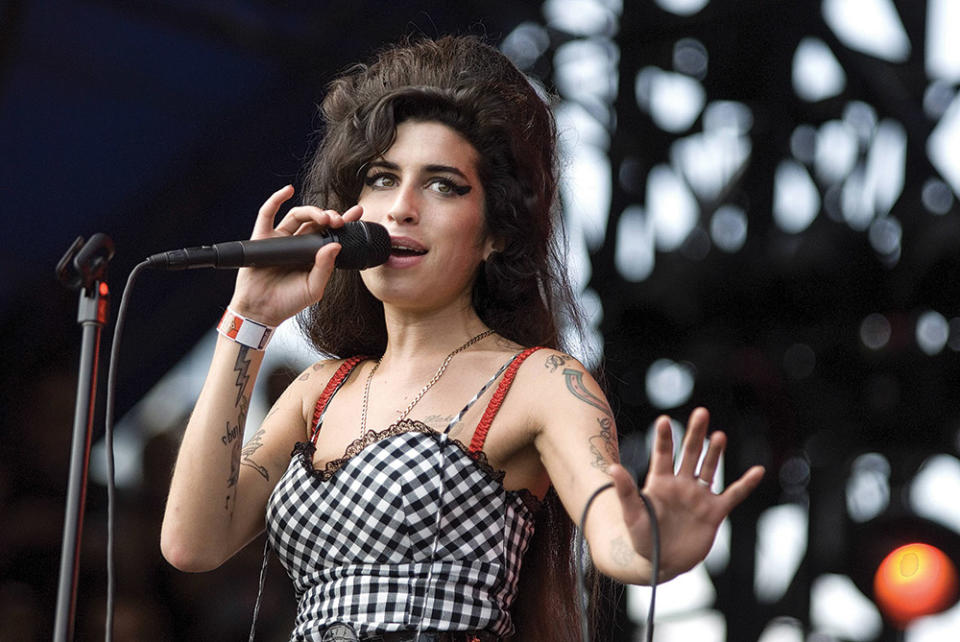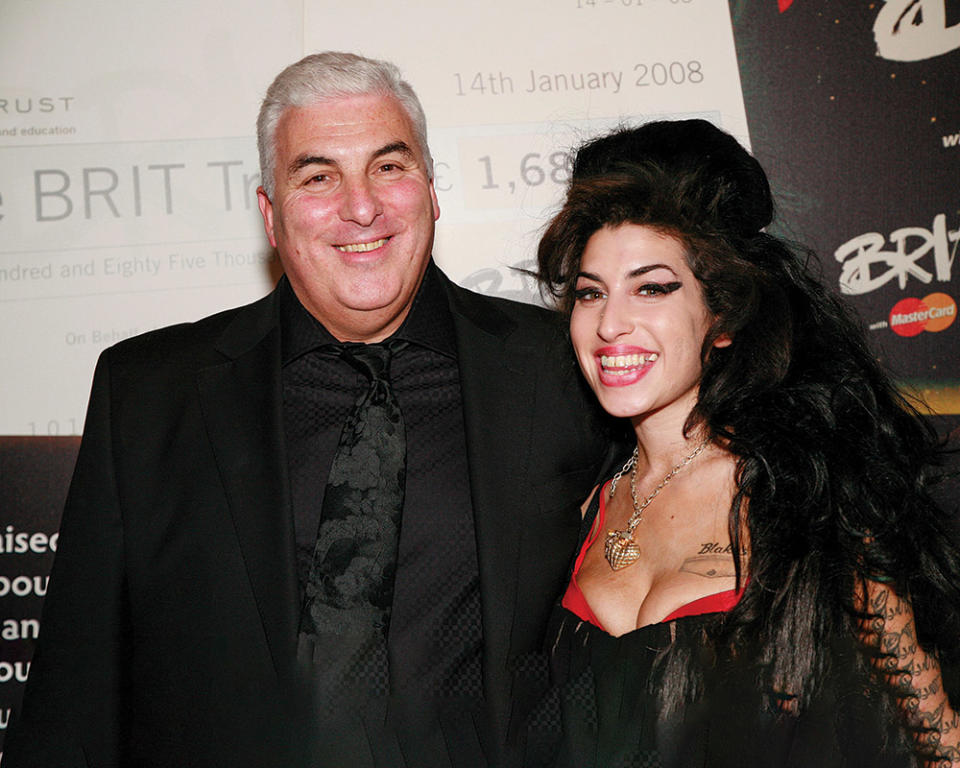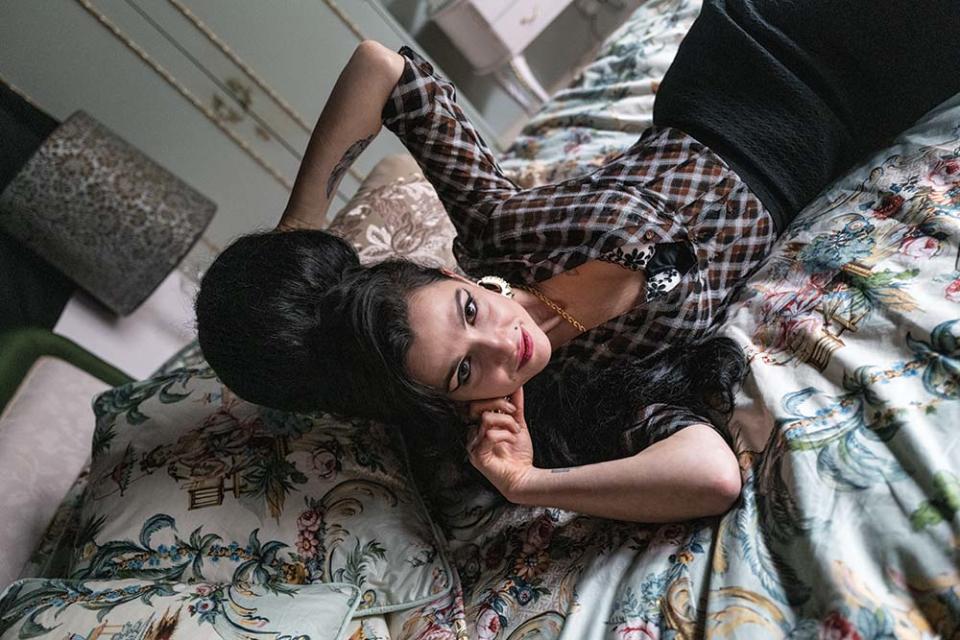The Renegade Director Reclaiming Amy Winehouse’s Soul

When Sam Taylor-Johnson started working on her Amy Winehouse biopic, Back to Black, she asked screenwriter Matt Greenhalgh to listen to one of Winehouse’s tracks, “Tears Dry on Their Own,” before he started writing. “I kept saying in those early days, ‘I feel like this song is our path to understanding her,’ ” Taylor-Johnson says.
In the deceptively upbeat single about Winehouse’s tumultuous relationship with her on-again, off-again love, Blake Fielder-Civil, she sings, “It’s my responsibility/And you don’t owe nothing to me.”
More from The Hollywood Reporter
Roger Federer Doc by Director Asif Kapadia Set at Prime Video
Watch the First Trailer for Amy Winehouse Biopic 'Back to Black'
For Taylor-Johnson, 57, that line spoke to something largely misunderstood about Winehouse, the English singer who died of alcohol poisoning in 2011: Just 27, she left behind an outsize cultural impact. Winehouse’s defining album, Back to Black, sold more than 16 million copies worldwide, and her unique mix of jazz and soul with punk-era defiance would go on to influence artists like Adele, Lady Gaga and Billie Eilish. After her death, fans and media pointed fingers at Winehouse’s family and at Fielder-Civil for enabling her drug use. “A lot of the narrative around Amy is, ‘Who’s to blame?’ ” Taylor-Johnson says. “But when someone’s saying, ‘No one’s to blame, it’s my responsibility,’ they’re saying, ‘I am not a victim. I am my own person who makes my own decisions.’ ”
Taylor-Johnson’s résumé — as the director of movies about a musical icon (2009 John Lennon biopic Nowhere Boy), a controversial romance (2015’s Fifty Shades of Grey) and an addict (2018’s A Million Little Pieces) — lined up well for the task of tackling Winehouse’s complicated biography. But beyond that, the English filmmaker brings a unique personal perspective as a woman who ascended quickly in the London art scene in her 20s and has lived in the glare of public curiosity about her marriage to much younger actor Aaron Taylor-Johnson, 33.
Winehouse’s story has been told before, in tabloid photographs of her stumbling barefoot through London streets, in multiple books and in the 2015 Oscar-winning Asif Kapadia documentary Amy, which starts with a home movie of her singing as a precocious 14-year-old and ends with footage of her funeral. What people hadn’t done much of, it seemed to Taylor-Johnson, was try to understand Winehouse through the autobiography she composed herself — her songs.
“Everything that she had achieved was being eclipsed by the tragedy of how her life ended,” Taylor-Johnson says. “In listening to her music, it was full of paradox and nuance in a way that seemed to have been neglected. I wanted to take her to a place where she had her agency back.”

Back to Black, which Focus Features will release in the United States on May 17 after StudioCanal opens it in the U.K. on April 12, stars Marisa Abela of HBO’s Industry as Winehouse. The actress sings the songs herself, save for one track heard on a jukebox. The $30 million film follows the singer beginning with her adolescence in North London, in a jazz-loving Jewish family with separated parents and a doting grandmother, and shows her dramatic ascent as an artist, in a career that culminated in the making of 2006’s Grammy-winning Back to Black. It ends in the hours before Winehouse died of alcohol poisoning. While the film doesn’t veer away from Winehouse’s well-documented struggles with addiction and bulimia, it spends more time on moments that have been less explored, like her electric first meeting with Fielder-Civil (Jack O’Connell) in a Camden bar and her intimate relationship with her grandmother Cynthia (Lesley Manville), a singer who influenced Winehouse’s retro taste and died just as her granddaughter’s music career was peaking.
It was British film producer Alison Owen (Elizabeth, Saving Mr. Banks), a Winehouse fan, who obtained permission to use the singer’s discography from rights holders Universal Music and Sony and recruited Taylor-Johnson to direct. “I didn’t want to make a small art movie,” Owen says. “I wanted to make something that would appeal commercially to a wider audience. And I know that Sam has the ambition and the aesthetic to do that.”
Taylor-Johnson met with Winehouse’s family, but says they had no input on her cut, nor do they benefit financially from the film. In fact, she says, she had one demand before taking the job: “It was taking on a big story with a lot of swirling interest and anxiety from people who hold her dear,” the director says. “I just didn’t want to have to have people to answer to. I had to be able to tell the story the way I wanted.”
***
Taylor-Johnson first heard Winehouse sing at a talent show at the London jazz club Ronnie Scott’s sometime near when her first album, 2003’s Frank, came out. “I distinctly remember it was such an old-soul voice attached to this very young, very shy girl,” she says. The daughter of a yoga teacher/astrologer whose parents divorced when she was 9, Taylor-Johnson grew up, like Winehouse, in an artistic and often chaotic home. By the time she was at Ronnie Scott’s that night, she had built a career as a fine-art photographer, won the most promising young artist prize at the 1997 Venice Biennale, married art dealer Jay Jopling and had a daughter. Though not exactly pop stardom, a young woman’s rise in the art world had its perils, too. “I remember the attention being so exhilarating and exciting at the beginning, until you feel the turn and actually not everyone’s supporting you in your ascendance,” Taylor-Johnson says. “And that confusion of, just like, ‘Why?’ ”

When she was 30, the year she won the award at Venice and had her first child, Taylor-Johnson’s life took a frightening turn, when she was diagnosed with colon cancer. Three years later, she got breast cancer. It’s an era of her life — one of surgeries, chemotherapy and extraordinary vulnerability — that was resurfaced recently when Taylor-Johnson watched the public speculation about Kate Middleton’s health. After suffering with the disease as a young mother, watching Middleton disclose her own cancer diagnosis was sobering. “You are absolutely in a state of trauma and survival,” she says. “All you really want to do is to cocoon yourself and your family. I felt pangs of anxiety around what she must be going through.” The media firestorm that surrounded Middleton’s health has echoes of the predatory relationship the English tabloids had with Winehouse, she says. “People just want more, more, more,” says Taylor-Johnson. “There’s a voracious appetite for needing every shred of information around somebody who’s so public.”
Taylor-Johnson’s own private life inspired speculation, too. After divorcing Jopling in 2008, she met Aaron Taylor-Johnson (then Aaron Johnson) on the set of Nowhere Boy, in which he played Lennon. She was 42 and he was 18, an age difference that raised eyebrows at the time, and continues to do so as they’ve both grown in fame, with him most recently starring opposite Ryan Gosling in The Fall Guy and appearing on many shortlists of potential James Bond actors. “There are times where it’s uncomfortable,” Taylor-Johnson says of the attention the couple inspires. “Most of the time we zone it out and stay pretty private. We tend to retreat. Kids and school runs keep you pretty grounded.”
The Taylor-Johnsons, who now live on a farm in Somerset, England, married in 2012, each taking the other’s name. They’ve raised her two daughters from her first marriage, now ages 26 and 17, and have two more daughters together, 12 and 13 — “four very strong, opinionated young women,” Taylor-Johnson says. Greenhalgh, a friend who also wrote Nowhere Boy, describes what he calls “Taylor-Johnson world” as “101 things going on at once, just wonderfully hectic.” Amid the activity of kids and dual high-profile artistic careers, “Sam is very cool,” he says. “And you feel cool hanging around with her.”
Taylor-Johnson’s biggest film by far was the $570 million-grossing Dakota Johnson and Jamie Dornan starrer Fifty Shades of Grey, on which she regularly battled over creative decisions with the blockbuster romance series’ author, E.L. James, who wanted to adhere closely to her source material. “This was her book and she had a very particular vision of how she wanted to see this film,” Taylor-Johnson says. “And I had a diametrically opposed vision. Where we got to is where we got to. The success of it was great, but the experience of it was tough.” After making the critically panned 2015 film, she says, “It took me about four years to regain my confidence and composure. I’m going back to being an artist where I can make all my own decisions, answer to myself and present the world with something that I’ve created.” She followed Fifty Shades with 2018’s A Million Little Pieces, which had its own problems, starting with the fact that the author of its source material, James Frey, was revealed to have fictionalized parts of what he had called a memoir. By the time Taylor-Johnson came aboard with her husband in the lead role, Frey had long since apologized and the literary furor had died down, but so had most of the interest in the film, which received a modest independent release and middling reviews. “I seem to pick these movies where people have a lot of opinions around the protagonist,” Taylor-Johnson says. “But I guess I must like that and be drawn to that kind of chaos.”

***
Much of the disagreement over Winehouse’s legacy has centered on the role of her father, Mitch, a cabdriver who’s portrayed in the Kapadia documentary as a greedy and uncaring operator who blithely ignored his daughter’s troubles. In her song “Rehab,” Winehouse sings about declining addiction treatment because “my daddy thinks I’m fine,” a conversation that is dramatized in the film, with actor Eddie Marsan in the role of Mitch. Marsan’s Mitch is a more sympathetic one than the man in the documentary — he comes across as ill-equipped to parent an addict, not exploitative. Taylor-Johnson says meeting Mitch and Janis, Winehouse’s mother (played by Juliet Cowan in the movie), shaped her treatment of them in the film. Janis sent Taylor-Johnson a playlist Amy had created — an eclectic collection of artists like Nina Simone, the British ska punk group The Specials and Lauryn Hill — and shared stories and mementos. “When [Janis] was pulling out Grammys, teddy bears, shoes, school uniforms, you realize you’re in the presence of a deeply grieving parent,” Taylor-Johnson says. “It just felt like they’re in a place of sadness, regret. All those nuances have been lost over the years, and it’s just, ‘This could have been done but wasn’t.’ It’s very hard to have that judgment when you’re faced with parents who’ve lost their child. We’ve lost a musician and icon, but for them it’s their child.”

In researching the script, Greenhalgh realized there was a key character in Winehouse’s life who was still largely unknown — her grandmother, whose death coincided with an acceleration of Winehouse’s addictions. “There’s a narrative here that’s been neglected, because it might not be clickbait for the tabloids,” Greenhalgh says. “It was an area which we could go into with some emotional depth, because not many people knew a lot about that relationship.” During the writing, Greenhalgh immersed himself in Winehouse’s world, placing a life-size cutout of her next to his desk and purchasing some of the Amy Winehouse temporary tattoos fans have popularized. “I was walking in and speaking to [the cutout], and she was saying, ‘Come on, get on with it,’ ” Greenhalgh says. “I just found her really amusing. We could be mates.”
Taylor-Johnson and casting director Nina Gold brought eight actresses in to read for the role of Amy, seven of whom came to their auditions in some version of Winehouse drag, wearing hoop earrings, scarves and heavy black eyeliner. Abela was the only actress to arrive as herself. “An impersonation only carries you so far,” Taylor-Johnson says. “With Marisa, she was so sweet and well-spoken, and that isn’t Amy.” After chatting, they began the audition. Taylor-Johnson turned on the camera and looked into the eyepiece to check the focus. “I saw Marisa look up and look into the lens, and I literally just took a breath and sat back. She hadn’t even said anything. And I thought, ‘It’s her.’ I just knew.” Abela had the voice and mannerisms right, but what was more important, Taylor-Johnson says, is that “I felt people would believe her.”
Abela, who’d previously only taken one singing class in acting school, wanted to master Winehouse’s distinctive singing voice and took two hours of singing lessons a day for four months. “The story we’re telling is through this music,” Abela says. “So it would feel so disappointing to do all of the emotional work for a scene and then get to the singing and open my mouth and cut to a track that has an emotional disconnect because it is recorded in the studio.”

She also spent those four months slowly losing weight with the help of a nutritionist in order to portray Winehouse at her most sick, from bulimia as well as addiction. “My goal was to get as fragile physically as possible whilst still being able to focus and work from a place that was full of energy,” Abela says. “I didn’t want to shy away from the fact that she suffered.” Taylor-Johnson shot those scenes first, so that Abela did not have to shed weight quickly during the production. “There’s a lot of emotion around women, especially, in that state,” Taylor-Johnson says, “so it felt like there had to be a very protective environment around her during that whole time. It was done with a lot of thought.” The film alludes to Winehouse’s bulimia, but never depicts it. “It just didn’t need glorification,” Taylor-Johnson says. “Sometimes what you don’t see is more powerful than what you do, like Jaws.”
The song that was Taylor-Johnson’s touchstone as she began the project, “Tears Dry on Their Own,” appears late in a crucial scene. “We know the ending, we know the tragedy,” she says. “But when you come out of the cinema, the goal is that you’ll go home and want to listen to her music.”
This story first appeared in the April 10 issue of The Hollywood Reporter magazine. Click here to subscribe.
Best of The Hollywood Reporter


